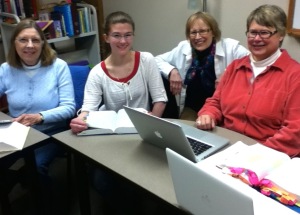From Sticky Notes to a 477-Page Book

Readers often want to know how this book came about—and here’s the answer:
Several years ago, I’d just finished a book, The Scarlet Cord: Conversation with God’s Chosen Women, telling the stories of twelve Bible women from a first-person perspective. Because women in the Bible tend not to say much, I filled in historical details where possible: why they took the actions they did, how they felt, who they loved.
Writing that book begged these questions: What DID Bible women actually say? How many were there? What were the broad themes among those who spoke? What are the surprises, those things that have been under our noses for centuries, but largely dismissed until now? What might their words mean for us today?
I asked who within the congregation (Trinity Episcopal Church in Excelsior, Minnesota, where I was working at the time), would be interested in researching Bible women and three people stepped up: the head of the altar guild, our church librarian, and a bright, home-schooled, high school girl.
We got out colored markers and sticky notes and read the Bible cover to cover, marking the words said by women, hand-counting them, recording them on spreadsheets (see appendices in back for details) and analyzing them in context of their larger stories. We met for two hours each week, worked at home for endless hours, laughed at seemingly bizarre narratives, and felt our stomachs grow upset upon reading some of the more tragic stories.
We talked with those in the field about Bible women who speak, but found few leads. Our research confirmed this conclusion: Until now, there has not been a systematic, reflective, analysis of which Bible women talked, what they said, how much they said, and what their words might mean for contemporary Christians.
Within that context, we moved forward. As we counted and double-counted each woman’s words, we explored the larger story surrounding each woman, looking for the eternal truths within…and our little group grew.
Another woman, a teacher, joined our efforts. A biblically accomplished Roman Catholic friend from Boston came on board via the internet, as did a missionary in Kenya and others who knew their Bibles well and who could answer questions on a moment’s notice.
Forward Movement, of Day by Day and Lent Madness fame, enthusiastically agreed to publish the findings, and the national Board of Directors for the Episcopal Church Women (ECW) joined the endeavor. A team of editors reviewed and re-checked the findings, and book hit the presses.
After three years, our research team, in addition to exploring all the women in the Bible who spoke, has consulted over a hundred books and websites, worked into many early morning hours, studied works by a range of Bible scholars—Christian, Jewish, feminist, evangelical, mainstream, and inter-religious—to accurately present the women who spoke in the Bible and what they said. We also consulted other sources, such as the Women’s History Project and Words Matter, a project of the National Council of Churches, and the Women for Justice Working Group.
I will always be indebted to this study group who stepped up to learn more about Bible women. They have made what was a dream into a reality. It is in God’s name that I share our findings.
Photo: Research partners (from left) Joyce White, Christy Stang, Lindsay Hardin Freeman and Sue Webster.


